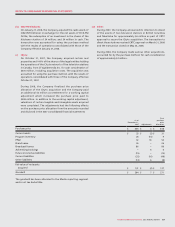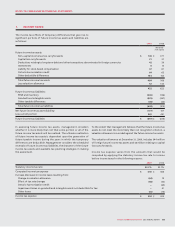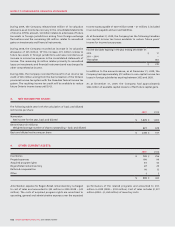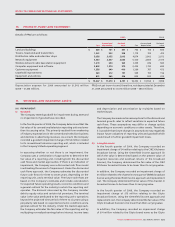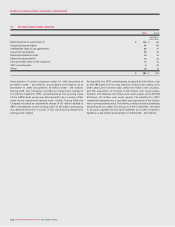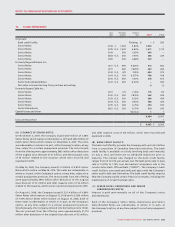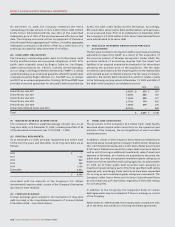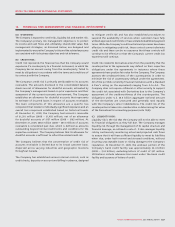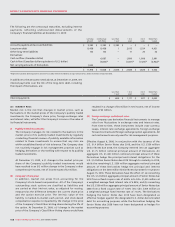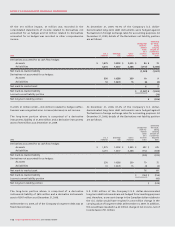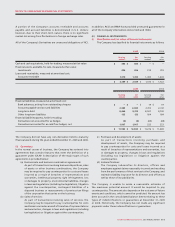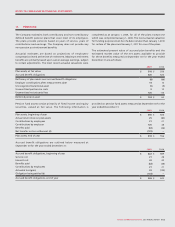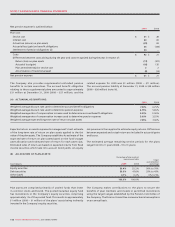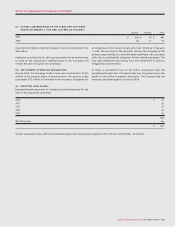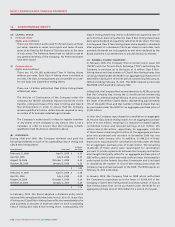Rogers 2009 Annual Report Download - page 103
Download and view the complete annual report
Please find page 103 of the 2009 Rogers annual report below. You can navigate through the pages in the report by either clicking on the pages listed below, or by using the keyword search tool below to find specific information within the annual report.
ROGERS COMMUNICATIONS INC. 2009 ANNUAL REPORT 107
NOTES TO CONSOLIDATED FINANCIAL STATEMENTS
(A) OVERVIEW:
The Company is exposed to credit risk, liquidity risk and market risk.
The Company’s primary risk management objective is to protect
its income and cash flows and, ultimately, shareholder value. Risk
management strategies, as discussed below, are designed and
implemented to ensure the Company’s risks and the related exposures
are consistent with its business objectives and risk tolerance.
(B) CREDIT RISK:
Credit risk represents the financial loss that the Company would
experience if a counterparty to a financial instrument, in which the
Company has an amount owing from the counterparty, failed to
meet its obligations in accordance with the terms and conditions of
its contracts with the Company.
The Company’s credit risk is primarily attributable to its accounts
receivable. The amounts disclosed in the consolidated balance
sheets are net of allowances for doubtful accounts, estimated by
the Company’s management based on prior experience and their
assessment of the current economic environment. The Company
establishes an allowance for doubtful accounts that represents
its estimate of incurred losses in respect of accounts receivable.
The main components of this allowance are a specific loss
component that relates to individually significant exposures and an
overall loss component established based on historical trends.
At December 31, 2009, the Company had accounts receivable
of $1,310 million (2008 – $1,403 million), net of an allowance
for doubtful accounts of $157 million (2008 – $163 million). At
December 31, 2009, $563 million (2008 – $614 million) of accounts
receivable is considered past due, which is defined as amounts
outstanding beyond normal credit terms and conditions for the
respective customers. The Company believes that its allowance for
doubtful accounts is sufficient to reflect the related credit risk.
The Company believes that the concentration of credit risk of
accounts receivable is limited due to its broad customer base,
dispersed across varying industries and geographic locations
throughout Canada.
The Company has established various internal controls, such as
credit checks, deposits on account and billing in advance, designed
to mitigate credit risk and has also established procedures to
suspend the availability of services when customers have fully
utilized approved credit limits or have violated established payment
terms. While the Company’s credit controls and processes have been
effective in mitigating credit risk, these controls cannot eliminate
credit risk and there can be no assurance that these controls will
continue to be effective or that the Company’s current credit loss
experience will continue.
Credit risk related to Derivatives arises from the possibility that the
counterparties to the agreements may default on their respective
obligations under the agreements in instances where these
agreements have positive fair value for the Company. The Company
assesses the creditworthiness of the counterparties in order to
minimize the risk of counterparty default under the agreements.
All of the portfolio is held by financial institutions with a Standard
& Poor’s rating (or the equivalent) ranging from A to AA-. The
Company does not require collateral or other security to support
the credit risk associated with Derivatives due to the Company’s
assessment of the creditworthiness of the counterparties. The
obligations under U.S. $5.5 billion aggregate notional amount
of the Derivatives are unsecured and generally rank equally
with the Company’s senior indebtedness. The credit risk of the
counterparties is taken into consideration in determining fair value
of the Derivatives for accounting purposes (note 15(d)).
(C) LIQUIDITY RISK:
Liquidity risk is the risk that the Company will not be able to meet
its financial obligations as they fall due. The Company manages
liquidity risk through the management of its capital structure and
financial leverage, as outlined in note 21. It also manages liquidity
risk by continuously monitoring actual and projected cash flows
to ensure that it will have sufficient liquidity to meet its liabilities
when due, under both normal and stressed conditions, without
incurring unacceptable losses or risking damage to the Company’s
reputation. At December 31, 2009, the undrawn portion of the
Company’s bank credit facility was approximately $2.4 billion
(2008 – $1.8 billion), excluding letters of credit of $47 million.
Utilizations include advances borrowed under the bank credit
facility and issuances of letters of credit.
15. FINANCIAL RISK MANAGEMENT AND FINANCIAL INSTRUMENTS:


